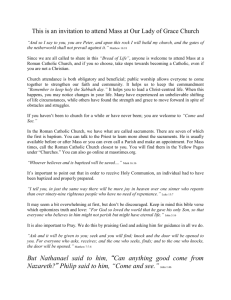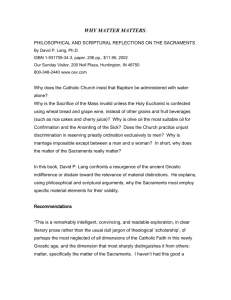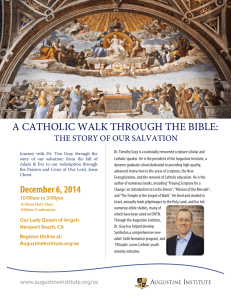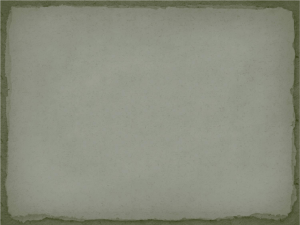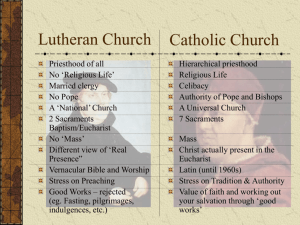Unit descriptions - Yarra Theological Union
advertisement
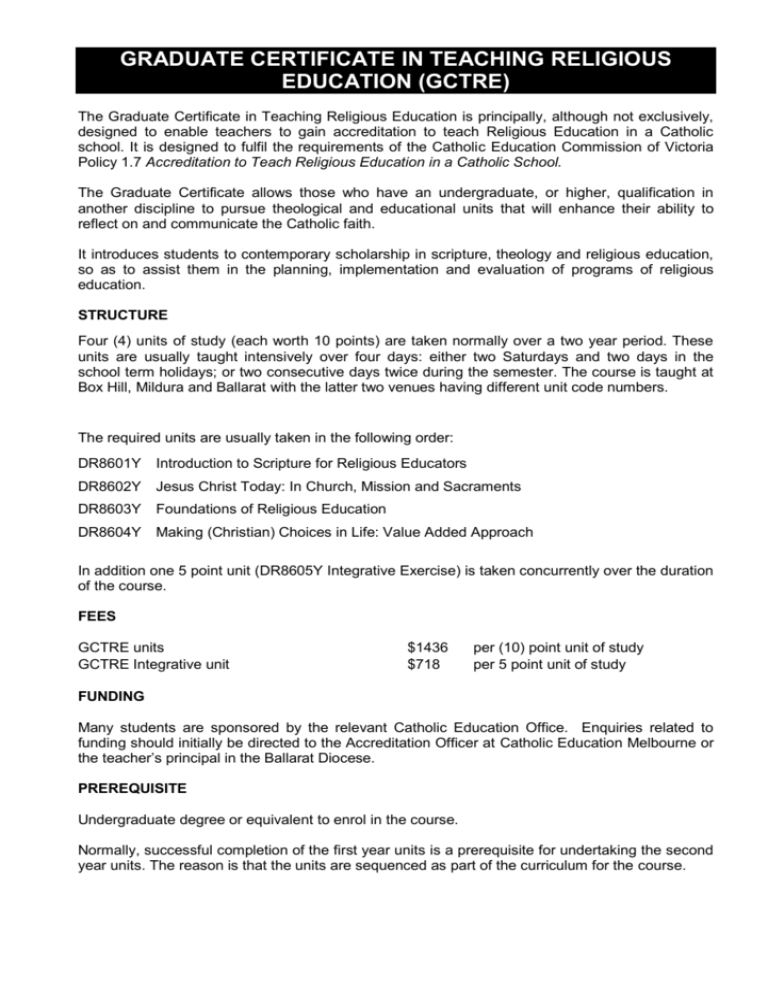
GRADUATE CERTIFICATE IN TEACHING RELIGIOUS EDUCATION (GCTRE) The Graduate Certificate in Teaching Religious Education is principally, although not exclusively, designed to enable teachers to gain accreditation to teach Religious Education in a Catholic school. It is designed to fulfil the requirements of the Catholic Education Commission of Victoria Policy 1.7 Accreditation to Teach Religious Education in a Catholic School. The Graduate Certificate allows those who have an undergraduate, or higher, qualification in another discipline to pursue theological and educational units that will enhance their ability to reflect on and communicate the Catholic faith. It introduces students to contemporary scholarship in scripture, theology and religious education, so as to assist them in the planning, implementation and evaluation of programs of religious education. STRUCTURE Four (4) units of study (each worth 10 points) are taken normally over a two year period. These units are usually taught intensively over four days: either two Saturdays and two days in the school term holidays; or two consecutive days twice during the semester. The course is taught at Box Hill, Mildura and Ballarat with the latter two venues having different unit code numbers. The required units are usually taken in the following order: DR8601Y Introduction to Scripture for Religious Educators DR8602Y Jesus Christ Today: In Church, Mission and Sacraments DR8603Y Foundations of Religious Education DR8604Y Making (Christian) Choices in Life: Value Added Approach In addition one 5 point unit (DR8605Y Integrative Exercise) is taken concurrently over the duration of the course. FEES GCTRE units GCTRE Integrative unit $1436 $718 per (10) point unit of study per 5 point unit of study FUNDING Many students are sponsored by the relevant Catholic Education Office. Enquiries related to funding should initially be directed to the Accreditation Officer at Catholic Education Melbourne or the teacher’s principal in the Ballarat Diocese. PREREQUISITE Undergraduate degree or equivalent to enrol in the course. Normally, successful completion of the first year units is a prerequisite for undertaking the second year units. The reason is that the units are sequenced as part of the curriculum for the course. DR8601Y INTRODUCTION TO SCRIPTURE FOR RELIGIOUS EDUCATORS DR8601Y Box Hill; DR8621Y Mildura; DR8641Y Ballarat Course: GCTRE See separate page on this site for schedule of dates (Min. No. 8) Unit Value: 10 points CONTENT This unit introduces teachers to the Scriptures by focussing on particular sections of the First (Old) and Second (New) Testaments and how these are interpreted within the Catholic tradition. It provides an overview of: the relationship between Scripture and Revelation, principles and methods of biblical interpretation, the significance of the Exodus and the Sinai covenant within Judaism and Christianity, the social, political and religious context of first century CE Judaism, and the formation of the Gospels. Passages will be chosen from Genesis 1-11, Exodus 1-14, Mark’s Gospel and Matthew 1-2 and Luke 1-2. LEARNING OUTCOMES Upon successful completion of this unit, it is expected that students will be able to: 1. recognise and describe the role of Scripture as witness to God’s revelation for members of the Jewish and Christian faiths 2. understand and explain why Scripture was written, and is read, in particular social, political and religious contexts 3. demonstrate an understanding that the Gospels present different ‘portraits’ of Jesus 4. identify methods of interpretation and engage in basic literary analysis of texts 5. apply learnings to support a position on the appropriate uses of Scripture in religious education ASSESSMENT 2000 word exegetical exercise (50%); 2000 word essay (50%) BIBLIOGRAPHY * = set texts recommended for purchase Brueggemann, Walter. An Introduction to the Old Testament. Louisville, KY: Westminster John Knox Press, 2003. Coloe, Mary L. The Two hands of God: Creation and Scripture. Mulgrave: Garratt Publishing, 2014. Coloe, Mary L. The Birth Stories of Jesus: Mulgrave: Garratt Publishing, 2015. Coogan, Michael D. The Old Testament: A Historical and Literary Introduction to the Hebrew Scriptures, Oxford University Press, 2006. Hendrickx, Herman. The Infancy Narratives. Rev. ed. London: Geoffrey Chapman, 1984. Monaghan, Christopher J. The Gospels: God with us. Mulgrave: Garratt Publishing, 2014 Moloney, Francis J. The Gospel of Mark: A Commentary. Peabody, MA: Hendrickson Publishers, 2002. Moloney, Francis J. The Gospel of Mark: A Commentary. Peabody, MA: Hendrickson Publishers, 2002. * _________. Reading the New Testament in the Church: A Primer for Pastors, Religious Educators and Believers. Mulgrave: Garratt Publishing, 2015. Rhoads, David. Mark as Story: Introduction to the Narrative of a Gospel. 2nd ed. Minneapolis, MN: Fortress, 1999. *Ryan, Maurice, ed. Reading the Bible: An Introduction for Student. Hamilton, Qld: Lumino Press, 2009. Scullion, J. J. Genesis. An Introduction for Students, Teachers and Preachers. Collegeville, MN: Liturgical Press, 1992. Witherup, Ronald D., ed. Christ in the Gospels of the Liturgical Year Raymond E. Brown, S.S. (1928–1998). Collegeville, MN: Liturgical Press, 2008. Lecturers: ROSE MARIE PROSSER, MARY COLOE PBVM and MARY REABURN NDS DR8602Y JESUS CHRIST TODAY: IN CHURCH, MISSION AND SACRAMENTS DR8602Y Box Hill; DR8622Y Mildura; Ballarat DR8642 Course: GCTRE Unit Value: 10 points See separate page on this site for schedule of dates (Min. No. 8) CONTENT This unit seeks to present with ecumenical sensitivity a general introduction to the origin, nature and development of the Church of Jesus Christ as the community of his followers. This entails an examination of the question ‘who is Jesus?’ On this foundation the unit presents the Church itself as the sign and instrument of Jesus Christ today, for the coming of the reign of God on earth. It is in this context that sacraments are understood as signs of the loving presence and self-giving of God in Christ. In developing this point the unit sketches the origin, nature and development of the Church’s ritual sacraments in reflecting and sustaining the Church in its mission. The unit’s consistent focus is on the whole Church as the Spirit-filled People of God and Body of Christ, and on the presence of the Holy Spirit in the life, sacraments, mission and ministries of the Church. LEARNING OUTCOMES Upon successful completion of this unit, it is expected that students will be able to: 1. outline the origin of the Church from the person of Jesus Christ and his early disciples 2. describe how the mission of the Church in the world today continues the mission of Jesus Christ 3. identify particular human experiences as possible signs and paths to the mystery of God 4. outline how the early Christians understood themselves as communities of Christ and their sacraments as celebrating their shared commitment to Christ and his mission. 5. explain how the Church’s ritual sacraments originate in both the Christ-event and in the Church’s response 6. describe the role of the Holy Spirit as the life and soul of the Church, its mission, its ministries, and its sacraments ASSESSMENT Two 2000 word essays (50% each) BIBLIOGRAPHY * = set texts recommended for purchase Bausch, William. A New Look at the Sacraments. Mystic, CT: Twenty-Third Publications, 1983 Chauvet, Louis-Marie. The Sacraments. Collegeville, MN: Liturgical Press, 2001. Cooke, Bernard. Sacraments and Sacramentality. Mystic, CT: Twenty-Third Publications, 1983. De Gidio, Sandra. Sacraments Alive: Their History, Celebration and Significance. Mystic, CT: Twenty-Third Publications, 1991. Fullenbach, John. Church: Community for the Kingdom. Maryknoll, NY: Orbis Books, 2002. Gaillardetz, Richard R. Ecclesiology for a Global Church: A People Called and Sent. Maryknoll, NY: Orbis Books, 2006. Guize, Tad. The Book of Sacramental Basics. New York/Ramsey, NJ: Paulist Press, 1981. Lohfink, Gerhard. Jesus of Nazareth: What He Wanted, Who He Was. Collegeville, MN: Michael Glazier/Liturgical Press, 2012. ________. No Irrelevant Jesus: On Jesus and the Church Today. Collegeville, MN: Michael Glazier/Liturgical Press, 2014. Martos, J. Doors to the Sacred: A Historical Introduction to Sacraments in the Catholic Church. Tarrytown, NY: Triumph Books, 2001. Morrill, Bruce. Divine Worship and Human Healing. Collegeville, MN: Liturgical Press, 2010. Noll, Ray. Sacraments: A New Understanding for a New Generation. Mystic, CT: Twenty-Third Publications, 1999. Lecturers: GREG BRETT CM and MICHAEL A KELLY CSsR DR8603Y FOUNDATIONS OF RELIGIOUS EDUCATION DR8603Y Box Hill; DR8623Y Mildura; DR8643Y Ballarat Course GCTRE Unit Value: 10 points See separate page on this site for schedule of dates (Min. No. 8) CONTENT This unit examines foundational issues concerning the nature, purpose, context and practice of religious education in the Catholic Christian tradition. The focus is on Catholic schooling in Australia and is informed by church documents, clarification of current terminology used in regard to religious education, and an explanation of the sources of revelation. Participants are introduced to the history of Catholic schooling in Australia and to the work of contemporary theorists of religious education. While emphasising the importance of Catholic identity and the roles of prayer, ritual, liturgy and social justice in the maintenance of that identity, there is also an exploration of the possibilities of enrichment through interfaith dialogue. LEARNING OUTCOMES Upon successful completion of this unit, it is expected that students will be able to: 1. articulate an understanding of the nuances of meaning in the term “religious education” and of the critical role played by context in the delivery of religious education 2. identify and explain the roles of scripture, tradition and experience in the processes of religious education 3. demonstrate knowledge of the social, political and religious context that gave rise to Catholic schools and of their evolution to the present 4. recognise, explain and assess the possibilities of some contemporary approaches to “religious education” 5. develop and critically evaluate a unit of work in religious education for delivery to a specific group of students 6. identify the roles of prayer, ritual, liturgy and social justice in the maintenance of Catholic identity and the possibilities of enrichment through interfaith dialogue ASSESSMENT 2000 word essay 50%; a unit of work (2000 words) 50% BIBLIOGRAPHY Archdiocesan Texts: Melbourne: To Know, Worship and Love: Ballarat: Awakenings Benjamin, Anne, and Dan Riley, eds. Catholic Schools: Hope in Uncertain Times. Mulgrave, VIC: John Garratt Publishing, 2008. Congregation for Catholic Education. The Catholic School on the Threshold of the Third Millennium. Boston, MA: Pauline Books and Media, 1998. D’Orsa, Jim, and Therese. A Mission to the Heart of Young People: Catholic Curriculum. Mulgrave, Vic: Vaughan Publishing, 2012. Groome, Thomas H. Christian Religious Education: Sharing Our Vision and Story. Blackburn, VIC: Dove Communications, 1980. ———. Will there be Faith? A New Vision for Educating and Growing Disciples. New York: Harper One, 2011. Lovat, Terence J. What is This Thing Called Religious Education: A Decade On? Katoomba, NSW: Social Science Press, 2002. Maher, Anthony, and Bob Hanley. Educating Hearts: Seven Characteristics of a Good School. Strathfield: St Pauls Publications, 2013. Pollefeyt, Didier, and Jan Bouwens. Identity in Dialogue: Assessing and enhancing Catholic school identity. Research methodology and research results in Catholic schools in Victoria, Auustralia. Zürich: LIT VERLAG GmbH & Co. KG Wien, 2014. Ryan, Maurice. A Common Search: The History and Forms of Religious Education in Catholic Schools. Hamilton, QLD: Lumino Press, 2007. Lecturer: MICHAEL A. KELLY CSsR DR8604Y MAKING OUR (CHRISTIAN) CHOICES IN LIFE: A VALUE ADDED APPROACH DR8604Y Box Hill; DR8624Y Mildura; DR8644Y Ballarat Course: GCTRE Unit Value: 10 points See separate page on this site for schedule of dates (Min. No. 8) CONTENT This unit has a threefold purpose. Drawing on scripture and Catholic theological tradition, the unit aims to provide a framework for understanding the nature and place of moral decision making in Christian living. It will explore methods and strategies for teaching Christian morality in Catholic schools, and provide opportunities for teachers to integrate their study of the scriptures, tradition and the sacraments into their own faith and professional development. Areas to be studied include the meaning of Christian morality, sources of moral knowledge, human freedom, sin and redemption, conscience formation, meaning and function of Church authority, and a strategy for making moral decisions in accordance with Church teaching LEARNING OUTCOMES Upon successful completion of this unit, it is expected that students will be able to: 1. identify the process of moral decision making in regard to current ethical questions 2. articulate the Catholic moral tradition on relevant issues 3. discuss current moral issues objectively, critically, and intelligently 4. apply Catholic moral methodology to the making of Christian moral choices 5. critique different perspectives on contemporary moral issues. 6. communicate in an age appropriate manner with students about the importance and relevance for (Christian) living of making (Christian) moral choices. 2,3,4,5 ASSESSMENT 1500 word written presentation (30%); 2500 word essay (70%) BIBLIOGRAPHY Curran, Charles, ed. Conscience: Readings in Moral Theology. No. 14. New York: Paulist Press, 2004. Curran, Charles, and Lisa Fullam, eds. Ethics and Spirituality: Readings in Moral Theology, No. 17 New York: Paulist Press, 2014. Gula, Richard. Call To Holines: Moral Discernment. New York: Paulist Press, 2003. Keenan, James F. Commandments of Compassion. Franklin, WI: Sheed & Ward, 1999. Lamoureux, Patricia and Paul J. Wadell The Christian Moral Life: Faithful Discipleship for a Global Society, Maryknoll, NY: Orbis Books, 2010. McBride, Alfred, Christ Our Compass: Making Moral Choices, Cincinnati, OH: Franciscan Media, 2013; Mattison, William C, III, Introducing Moral Theology: True Happiness and the Virtues, Grand Rapids, MI: Brazen Press, 2008. Mordini, Tony. Ethics for Today: Analyzing Values and Beliefs. Melbourne, VIC: John Garratt Publishing, 2002. Nichols, Alan. Street called Choice: Ethical Choices for Ordinary People. Melbourne, VIC: Acorn Press, 2005. Shelton, Charles. Achieving Moral Health: An Exercise Plan for Your Conscience. New York: Crossroad Publishing, 2000. Lecturers: PHILIP MALONE MSC AND BERNARD TEO CSsR DR8605Y INTEGRATIVE EXERCISE DR8605Y Box Hill; DR8625Y Mildura; DR8645Y Ballarat Course: GCTRE Unscheduled (Min. No. 8) Unit value: 5 points CONTENT This unit is taken concurrently with the other units in the GCTRE program. It provides the student with an opportunity for personal appropriation, synthesis and integration of content, skills and formative experiences provided in these units. COREQUISITES DR8601Y, DR8602Y, DR8603Y, DR8604Y LEARNING OUTCOMES Upon successful completion of this unit, it is expected that students will be able to: 1. articulate the personal and professional learning that has occurred 2. discuss the implications for this learning in their delivery of religious education in a Catholic school. ASSESSMENT Each of the four integrative exercises will require the student to write a 500 word reflection paper (25% each) which will be graded as Pass/Fail. When the four integrative exercises have been successfully completed the student will have earned the final five points required for the award of the Graduate Certificate in Teaching Religious Education.

